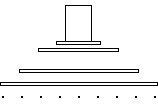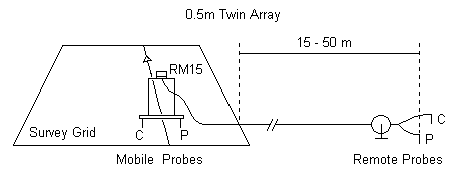|
ADAPTERS (RM15-D only, some RM85 adapters are different)
The lead from the PA20 frame terminates in a 6-way waterproof plug which must be connected to the 2-way connector on the RM15(-D) or RM4 resistance meter. This may be achieved using either individual adapters for different arrays or the MPX15 multiplexer (RM15-D only) which will interface virtually all arrays.
AD1 and AD3 The most popular adapter is the AD1 (029-020) which is suitable for configuring a single Twin probe array of any spacing (0.25m to 2m). The next most popular adapter is the AD3 (029-022) which enables a 0.5m Wenner, 0.5m Double-Dipole or mini-Schlumberger array to be configured (the remote probes and cable are not used in these cases, but two additional stainless steel probes, 019-023, are required).
AD2 The Gradient array adapter, AD2 (029-022), connects the two potential pins of the resistance meter to the frame, and connects the two current pins of the resistance meter to leads terminated with 4mm socket. Two additional 50m small cables (019-015 for a pair) are required to connect these to two remote current probes which can be the pair provided with the standard system. Alternatively, two of the leads and probes from the PA3 probe array (see separate data sheet) may be used instead.
AD4 The AD4 adapter (029-023) will convert all Twin arrays into the Pole-Pole equivalents. This adapter converts the "Remote Probes" two-pole connector on the RM15(-D), RM4 or MPX15 into two separate leads (current and potential), each terminated in a flying 4mm socket. As for the AD2, two additional 50m small cables (019- 015 for a pair) are required to connect these to the remote probes. The AD4 may be used with both the MPX15 multiplexer and AD1 adapter.
Extension Leads
Remote probe Extension leads, each 25m long, are advised when using longer beams in order to minimise variation of readings over a grid due to geometry effects. They will enable larger areas to be surveyed from the same remote probe position and can simplify grid matching if a wide remote probe spacing (5-10m) is used.
MPX15 MULTPLEXER (RM15-D only)
The MPX15 multiplexer (not compatible with RM4) effectively integrates adapters AD1, AD2 and AD3 into one box, though an AD4 will still be required for the Pole-Pole array, and additional 50m cables will be required for both Pole-Pole and Gradient arrays. The AD1 may still be a useful lightweight addition to your system if a single twin probe array is to be used frequently. Of course, the MPX15 offers much greater scope than is possible with just single measurement sequences and adapters. The MPX15 may be used to configure single, parallel or multiple arrays, offering much faster or more detailed area coverage, or depth investigation (see MPX15 data sheet for more details).
ENVIRONMEMTAL CONDSIDERATIONS
Great care has been taken to maximise the conditions in which the PA20 can be used. However, regular cleaning by the user is required to avoid tracking problems in wet and muddy conditions. Since all probes need to make simultaneous contact, some terrains may cause problems, especially if there are 6 probes on a wide frame. For example very dry, hard and stony ground may be difficult to survey with a 2m frame. However, on more moist ground, surface contact is usually sufficient to obtain good readings, even in auto-log mode. If the ground is moist then even where there is a pronounced undulation, the probes need only be inserted 1 cm to obtain good readings.
PA20 PERFORMANCE
The standard 0.5m Twin array finds greatest application in archaeological surveys as many features are near surface, and speed, ease of use, simple response and excellent resolution (approximately 0.5m) is often of greater importance than detection depth limitations (0.5m - 0.75m for typical archaeological targets). Where more substantial structures are involved, such as capped mine shafts, detection depth can be greater. Detection depth can be improved by increasing the Twin array size, giving a commensurate increase in detection depth. However, this will be at the expense of resolution, and if there are near surface features present, narrower than the array dimensions, these may give rise to multiple responses (or artefacts). Nevertheless, providing one remains aware of such possibilities during interpretation, useful information at greater depths can be achieved. The standard PA20 can be configured as a Twin array up to 1m wide, whilst the addition of beams can increase the array size up to 2m, giving up to a four-fold increase in detection depth.
|
|










